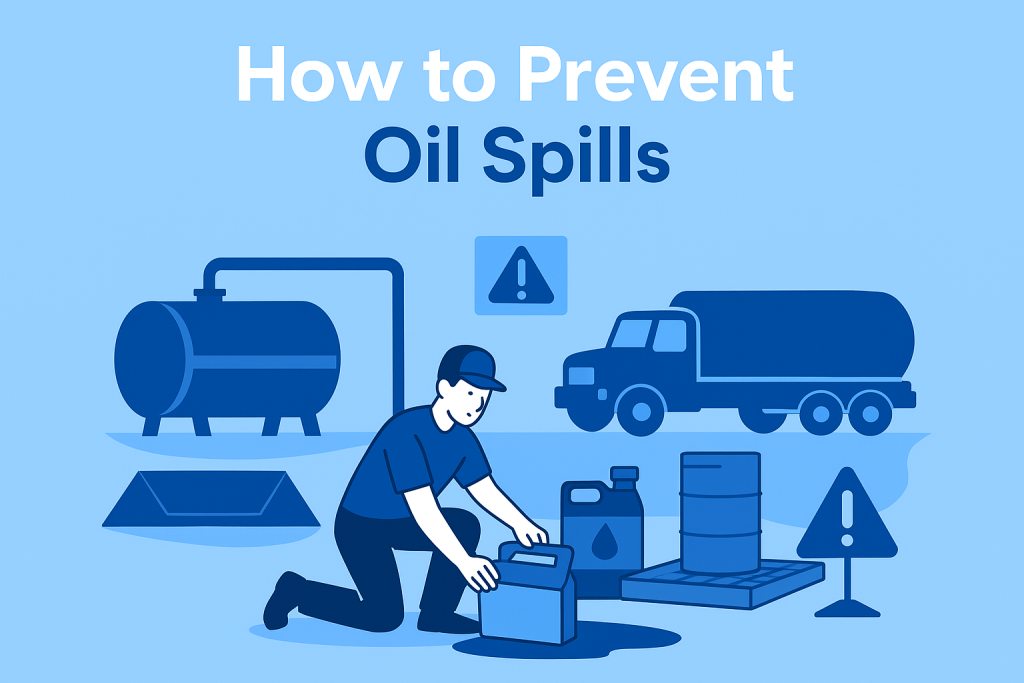Oil spills—whether from diesel, DEF, or other fluids—are not only costly but also harmful to your yard, fleet, and the environment. They can damage equipment, create safety hazards for your team, and trigger regulatory fines. Knowing how to prevent oil spills is a critical responsibility for fleet operators and facility managers.
This guide walks you through effective prevention strategies, essential spill response tools, and compliance tips to help you stay safe and operationally efficient.
Key Takeaways
- Knowing how to prevent oil spills protects your fleet, yard, team, and the environment.
- Prevention strategies include containment berms, spill pallets, inspections, correct storage, and employee training.
- A clear step-by-step spill response guide ensures workers know how to stop, contain, clean, report, and review any incident.
- Spill kits, PPE, emergency shutoffs, and monthly training drills are essential for preparedness.
- Compliance with EPA and OSHA regulations is not optional—it’s a requirement.
- Investing in the right equipment and training now prevents costly fines, cleanup, and downtime later.
What we’re going to learn:
Why Oil Spill Prevention Matters
Oil spills pose risks far beyond stains on your yard. They can:
- Contaminate soil and water sources
- Increase fire hazards around fueling stations
- Damage fleet equipment and vehicles
- Lead to costly cleanups and government fines
According to OSHA’s Emergency Preparedness Guide, proper prevention and response protocols are legally required for any fleet handling diesel, DEF, or oil-based fluids.
Common Causes You Must Know in How to Prevent Oil Spills
Understanding causes helps you prevent them:
- Overfilled storage tanks or fuel trucks
- Leaks from hoses, fittings, or valves
- Improper fluid transfer during refueling
- Poorly maintained equipment
- Lack of employee training or safety drills
Best Practices: How to Prevent Oil Spills in Your Fleet Yard
Install Secondary Containment
Containment berms under tanks prevent spills from spreading across your yard.
Use Spill Pallets & Drip Trays
Totes, drums, and smaller containers should sit on pallets designed to catch leaks.
Maintain Proper Tank & Equipment Inspections
Regularly check for cracks, leaks, or signs of corrosion in tanks and fueling systems.
Train Your Team in Spill Response
Every driver, operator, and yard worker should know exactly what to do when a spill occurs. Training ensures that small leaks don’t turn into major disasters. Here’s a practical step-by-step response guide you can adapt for your fleet:
1. Immediate Response Protocol
- Stop the source of the spill (shut off pumps, close valves, or upright containers).
- Ensure personal safety by wearing proper PPE (gloves, goggles, and absorbent suits if needed).
2. Contain the Spill
- Place absorbent socks or pads around the spill.
- Use containment berms if available to prevent spreading.
- Protect drains with covers to avoid contamination.
3. Clean Up Safely
- Use spill kits to soak up oils and fluids.
- Collect contaminated absorbents in disposal bags.
- Never hose down spills—this spreads contamination.
4. Report & Document
- Notify supervisors and follow your company’s spill reporting procedure.
- Record the incident for compliance with EPA/OSHA standards.
5. Conduct Post-Spill Review
- Review what caused the spill and how it was handled.
- Update procedures or add training if gaps are identified.
💡 Pro Tip: Schedule monthly spill response drills with your team. Just like fire drills, they keep everyone prepared to act quickly in an emergency.
Label & Store Fluids Correctly
Organized, labeled containers reduce accidents and ensure safe transfers.
👉 For tanks, storage solutions, and compliance-ready equipment, visit DEFN Oil Solutions.
Spill Cleanup Essentials You Should Have On-Site
Even with prevention, accidents can happen. Be prepared with:
- Spill kits stocked with absorbent pads, socks, and PPE
- Emergency shutoff switches on pumps and fueling stations
- Drain covers to prevent contamination of stormwater systems
- Training drills so employees can act fast and effectively
Regulatory Compliance & Safety Standards for How to Prevent Oil Spills
Oil spill prevention isn’t optional—it’s the law. Businesses must comply with:
- EPA’s Spill Prevention, Control, and Countermeasure (SPCC) Rule
- OSHA safety standards for handling hazardous fluids
- Local environmental protection regulations
Failure to comply can lead to fines, lawsuits, and costly remediation efforts. Prevention is always cheaper than cleanup.
Preventing oil spills isn’t just good practice—it’s part of a broader safety strategy that ties directly into Fleet Management: Optimize Fuel Systems, Compliance & Safety. Understanding fleet-wide compliance helps ensure that your operations remain efficient, spill-free, and in line with regulations.
Conclusion
Understanding how to prevent oil spills is essential for keeping your operations safe, compliant, and environmentally responsible. By combining prevention tools—like spill pallets, containment berms, and inspections—with hands-on employee training and clear response procedures, you’ll minimize risks and protect your fleet.
At the end of the day, how to prevent oil spills isn’t just about avoiding regulatory fines—it’s about protecting your people, your equipment, and the communities you serve.
👉 Ready to secure your fleet yard with the right equipment? Explore solutions at DEFN Oil Solutions and take the first step in preventing oil spills today.
FAQs
1. Most effective strategies for how to prevent oil spills?
Answer: Installing secondary containment systems and regularly inspecting tanks are the most effective strategies.
2. Do small spills need to be reported?
Answer: Yes, depending on local regulations. Even small spills can contaminate groundwater or soil.
3. How often should I inspect fuel tanks?
Answer: At least monthly, with immediate repairs made to any leaks or damage.
4. What should be in an oil spill kit?
Answer: Absorbent pads, socks, PPE (gloves, goggles), disposal bags, and emergency instructions
5. Is training employees required?
Answer: Yes, OSHA requires employee training for spill response and safety preparedness.

